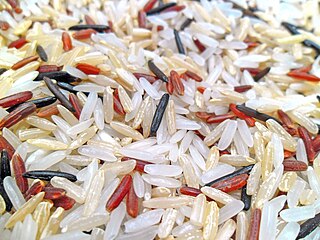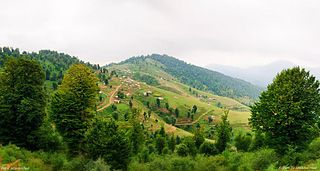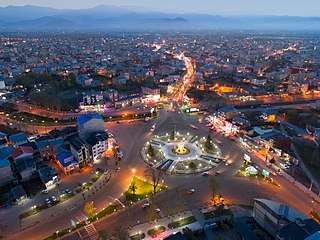Related Research Articles

Rice is the seed of the grass species Oryza glaberrima or Oryza sativa. As a cereal grain, it is the most widely consumed staple food for a large part of the world's human population, especially in Asia and Africa. It is the agricultural commodity with the third-highest worldwide production, after sugarcane and maize.

Proline (symbol Pro or P) is an organic acid classed as a proteinogenic amino acid (used in the biosynthesis of proteins), although it does not contain the amino group -NH
2 but is rather a secondary amine. The secondary amine nitrogen is in the protonated NH2+ form under biological conditions, while the carboxy group is in the deprotonated −COO− form. The "side chain" from the α carbon connects to the nitrogen forming a pyrrolidine loop, classifying it as a aliphatic amino acid. It is non-essential in humans, meaning the body can synthesize it from the non-essential amino acid L-glutamate. It is encoded by all the codons starting with CC (CCU, CCC, CCA, and CCG).

Azadirachta indica, commonly known as neem, nimtree or Indian lilac, is a tree in the mahogany family Meliaceae. It is one of two species in the genus Azadirachta, and is native to the Indian subcontinent. It is typically grown in tropical and semi-tropical regions. Neem trees also grow in islands located in the southern part of Iran. Its fruits and seeds are the source of neem oil.

A mango is a stone fruit produced from numerous species of tropical trees belonging to the flowering plant genus Mangifera, cultivated mostly for their edible fruit. Most of these species are found in nature as wild mangoes. The genus belongs to the cashew family Anacardiaceae. Mangoes are native to South Asia, from where the "common mango" or "Indian mango", Mangifera indica, has been distributed worldwide to become one of the most widely cultivated fruits in the tropics. Other Mangifera species are grown on a more localized basis.

Gilan Province, is one of the 31 provinces of Iran. It lies along the Caspian Sea, in Iran's Region 3, west of the province of Mazandaran, east of the province of Ardabil, and north of the provinces of Zanjan and Qazvin. It borders the Republic of Azerbaijan in the north and Russia across the Caspian Sea.

Astara is a city and capital of Astara County, Gilan Province, Iran. It lies on the border with Azerbaijan Republic and on the Caspian Sea. It is an important border trade center between Iran and the Caucasus.

Plant callus is a growing mass of unorganized plant parenchyma cells. In living plants, callus cells are those cells that cover a plant wound. In biological research and biotechnology callus formation is induced from plant tissue samples (explants) after surface sterilization and plating onto tissue culture medium in vitro. The culture medium is supplemented with plant growth regulators, such as auxin, cytokinin, and gibberellin, to initiate callus formation or somatic embryogenesis. Callus initiation has been described for all major groups of land plants.

Talesh County, also called Tavalesh is a county in Gilan Province in Iran. The capital of the county is Hashtpar.

Roughly one-third of Iran's total surface area is suited for farmland, but because of poor soil and lack of adequate water distribution in many areas, most of it is not under cultivation. Only 12% of the total land area is under cultivation but less than one-third of the cultivated area is irrigated; the rest is devoted to dryland farming. Some 92 percent of agricultural products depend on water. The western and northwestern portions of the country have the most fertile soils. Iran's food security index stands at around 96 percent.

Hygromycin B is an antibiotic produced by the bacterium Streptomyces hygroscopicus. It is an aminoglycoside that kills bacteria, fungi and higher eukaryotic cells by inhibiting protein synthesis.

Peonidin is an O-methylated anthocyanidin derived from Cyanidin, and a primary plant pigment. Peonidin gives purplish-red hues to flowers such as the peony, from which it takes its name, and roses. It is also present in some blue flowers, such as the morning glory.
The Scutellum is part of the structure of a barley and rice seed—the modified seed leaf.

Sowme'eh Sara is a city and capital of Sowme'eh Sara County, Gilan Province, Iran. At the 2006 census, its population was 40000(just in city), in 10,070 families.

Anthocyanins are water-soluble vacuolar pigments that, depending on their pH, may appear red, purple, blue or black. Food plants rich in anthocyanins include the blueberry, raspberry, black rice, and black soybean, among many others that are red, blue, purple, or black. Some of the colors of autumn leaves are derived from anthocyanins.
Plant tissue culture is a collection of techniques used to maintain or grow plant cells, tissues or organs under sterile conditions on a nutrient culture medium of known composition. It is widely used to produce clones of a plant in a method known as micropropagation. Different techniques in plant tissue culture may offer certain advantages over traditional methods of propagation, including:

Fuman is the capital of Fuman County in Gilan Province, Iran. At to the 2006 census, its population was 27,763 in 7,728 families.
In statistical genetics, inclusive composite interval mapping (ICIM) has been proposed as an approach to QTL mapping for populations derived from bi-parental crosses. QTL mapping is based on genetic linkage map and phenotypic data and attempts to locate individual genetic factors on chromosomes and to estimate their genetic effects.
Rhizobium gallicum is a Gram-negative root-nodule bacterium. It forms nitrogen-fixing root nodules on legumes, being first isolated from those of Phaseolus vulgaris.
Swapan Kumar Datta is a well known scientist (Professor) of rice biotechnology. He is well known for his pioneering research on genetic engineering of Indica rice. Dr. Datta has demonstrated the development of genetically engineered Indica rice from protoplast derived from haploid embryogenic cell suspension culture. Golden Indica Rice with enriched Provitamin A and Ferritin rice with high iron content were developed by his group with a vision to meet the challenges of malnutrition in developing countries. Prof. Swapan Datta has been named as one among the top 25 Indian scientists from all fields of science by India Today.
References
- ↑ Pazuki, Arman & Sohani, Mehdi (2013). "Phenotypic evaluation of scutellum-derived calluses in 'Indica' rice cultivars" (PDF). Acta Agriculturae Slovenica. 101 (2): 239–247. doi:10.2478/acas-2013-0020 . Retrieved February 2, 2014.
- Pazuki, Arman & Sohani, Mehdi (2013). "Phenotypic evaluation of scutellum-derived calluses in 'Indica' rice cultivars" (PDF). Acta Agriculturae Slovenica. 101 (2): 239–247. doi:10.2478/acas-2013-0020 . Retrieved February 2, 2014.